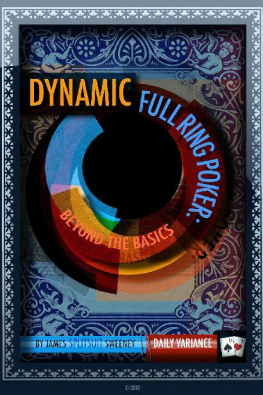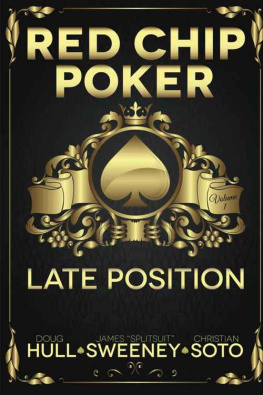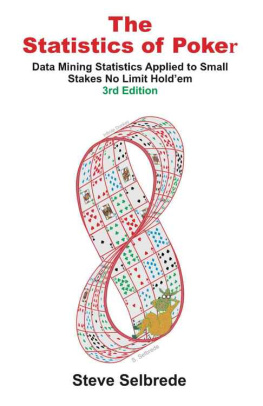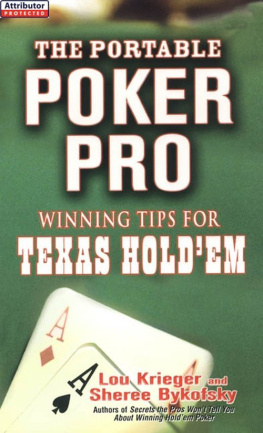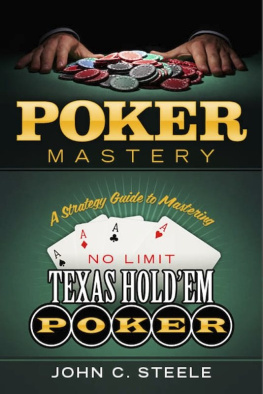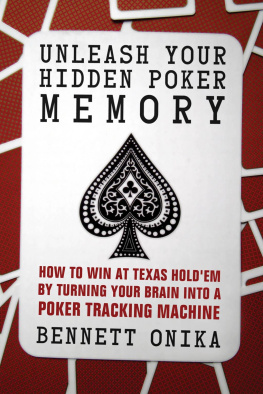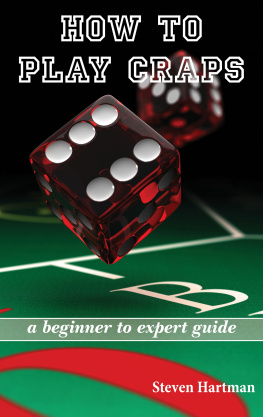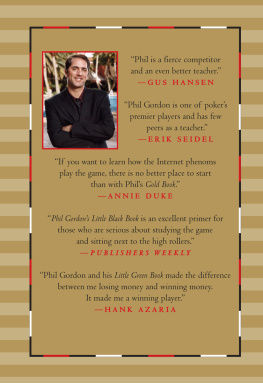James Sweeney - Dynamic Full Ring Poker: A Practical Guide to Crushing $1/2 No-Limit Holdem
Here you can read online James Sweeney - Dynamic Full Ring Poker: A Practical Guide to Crushing $1/2 No-Limit Holdem full text of the book (entire story) in english for free. Download pdf and epub, get meaning, cover and reviews about this ebook. year: 2011, genre: Home and family. Description of the work, (preface) as well as reviews are available. Best literature library LitArk.com created for fans of good reading and offers a wide selection of genres:
Romance novel
Science fiction
Adventure
Detective
Science
History
Home and family
Prose
Art
Politics
Computer
Non-fiction
Religion
Business
Children
Humor
Choose a favorite category and find really read worthwhile books. Enjoy immersion in the world of imagination, feel the emotions of the characters or learn something new for yourself, make an fascinating discovery.
- Book:Dynamic Full Ring Poker: A Practical Guide to Crushing $1/2 No-Limit Holdem
- Author:
- Genre:
- Year:2011
- Rating:5 / 5
- Favourites:Add to favourites
- Your mark:
- 100
- 1
- 2
- 3
- 4
- 5
Dynamic Full Ring Poker: A Practical Guide to Crushing $1/2 No-Limit Holdem: summary, description and annotation
We offer to read an annotation, description, summary or preface (depends on what the author of the book "Dynamic Full Ring Poker: A Practical Guide to Crushing $1/2 No-Limit Holdem" wrote himself). If you haven't found the necessary information about the book — write in the comments, we will try to find it.
Dynamic Full Ring Poker: A Practical Guide to Crushing $1/2 No-Limit Holdem — read online for free the complete book (whole text) full work
Below is the text of the book, divided by pages. System saving the place of the last page read, allows you to conveniently read the book "Dynamic Full Ring Poker: A Practical Guide to Crushing $1/2 No-Limit Holdem" online for free, without having to search again every time where you left off. Put a bookmark, and you can go to the page where you finished reading at any time.
Font size:
Interval:
Bookmark:
James SplitSuit Sweeney began playing poker in 2004. What started as home games and smaller tournaments soon turned into a business. From grinding live games at Turning Stone Casino, to SNGs, to PLO8 cash games, James quickly began to strengthen his poker theory and strategies. In 2007 James returned to his NLHE roots and began grinding full ring cash games. Interested in not only playing, but sharing his knowledge, he began taking on students.
Over the years his coaching methedologies have only improved, and he has coached over 300 students in that time. He also began making training videos for the once Stox Poker Training, and is now on the CardRunners roster as well. Teaching has been a passion of James, and poker was the perfect outlet given the various strategic levels the game offers. In late 2010 James finished his first book, and he plans on writing another one in 2011. While poker will always be a semi-professional avenue for him, James hopes to always be teaching at a professional level.
A graduate in Marketing from Syracuse University, James coaches and offers various coaching mediums at splitsuit.com.
Copyright 2010 DailyVariance Publishing, LLC
Published by DailyVariance Publishing, LLC
All rights reserved.
No part of this book may be reproduced or transmitted in any form, by any means, electronic or mechanical, including photocopying and recording, or by any information storage or retrieval system, without written permission from the publisher.
To request permission to use any part of this book in any way, write to:
ISBN 10: 0-9824022-9-5
ISBN 13: 978-0-9824022-9-0
To order additional copies, visit www.DailyVariance.com
by Steve Sundberg
As a poker coaching student of his, James SplitSuit Sweeney asked me how this book is different than the other poker books I have read. I will answer that question with a quick story:
A recent popular book stated that the winning style to beat online 200NL 6 max was LAG (loose aggressive.) So of course, I start playing loose and aggressive. At the time, my hand reading skills were virtually non-existent. One of the things the book implied, that I missed, was that to in order to play a profitable LAG style, you need to be a good hand reader. In addition to that, the popular poker forums hype up the LAG style, and imply that nits are a pariah of the poker society. Not wanting to be a pariah, I adopted the LAG strategy, which ultimately would have been described as a LAG-fish style. Being a tuna in a shark tank, while foolishly thinking I was also a shark, was a recipe for disaster.
Then I was introduced to James concept of frameworks presented in this book. This is a technique of breaking down a hand into simple components. Components that can be quickly and easily analyzed during a hand to make a decision. This is the first area where this book is different than others.
Most other books tell you to do Y in situation X. However, we rarely run into EXACTLY situation X when we are actually playing. We run into slight variations of X, and usually optimal play would necessitate variations in our lines and actions. Humans intuitively seek to find a simple set of rules that they can easily apply in poker and life (do X if Y). The problem is that poker is very complex. So much information needs to be gathered, analyzed, and processed into an optimal line. Which can be especially difficult while playing online, when the decision needs to be made quickly.
Next, this book differs dramatically in the explanation of poker theories. They are broken down simply, with minimal jargon, so that poker players of all levels are able to understand and utilize them. After reading this, you should be equipped with the necessary theoretical understanding to find solutions to your poker problems.
Which leads to the final area where this book diverges from others. Since it explains the underlying theory behind a line, you are able to adjust the application of the theory as the game conditions change.
Most books give strategy based on the game conditions relevant when the book was published. Especially in online poker, game conditions can literally change daily, especially after a popular online coach publishes a new article or video. Within weeks, even the fish seem to be trying the new line. With this book, you have the necessary information to adapt to the ever-changing game conditions.
In a nutshell, after reading this book, you should have the tools necessary to:
- Evaluate your hand
- Evaluate your opponent (his likely range, mistake propensity, etc.)
- Decide on the most profitable line to take based on the above
- Evaluate board textures and create profitable lines around them
- Optimally adjust your strategy as the games mature and change
This book contains too much info to process all at once, especially for the typical micro or low limit player, for whom much of this information will be new or clarified. I would recommend reading this entire book actively, by creating an outline as you read, highlighting any areas that are new or complex.
Then create a plan based on your current strengths and weaknesses, and decide on which strategies presented you are going to focus on first. Reread those sections, and focus on applying the concepts during a session. Then go back and re-read the section. I bet you will be surprised at what you missed or misunderstood. I know when I read the Isolating chapter, I repeated this process 3 times before I finally applied it correctly. Which reminds me I think I'll review that one more time to be sure it's now in my unconscious competence!
Steve Sundberg
My name is James Sweeney and I go by SplitSuit or *Split* on various poker forums. I began playing this game back in 2004 at college, and I have loved the game ever since. When I began playing I was terrible. I actually read a LHE book while trying to learn NLHE, and would bet because it was funny. Since then, I have put thousands of hours into improving my poker knowledge and putting that knowledge to use in a wide array of games.
This book is my first attempt at putting the knowledge I have gathered into an organized piece of writing. I have written many articles in the past, and various scripts for different training videos. But this is the first time I have ever tried to tackle a project this big and comprehensive. I would like to think that I did a good job at it, but of course you will have to be the judge of that.
Simply put, this book is a little different than other strategy books. My main gripe with most other strategy books, and most any strategic medium, is that they preach the what rather than the why. The why is the most vital piece of anything we do in poker, or in life. This book doesnt aim to give you a play and then tell you to go use it. It aims to talk about what goes into making a play, which parameters are favorable or otherwise, and then why we can use the play. This is the crux of poker knowledge. If you simply ask yourself why am I doing X? , then you are giving yourself an automatic edge.
In trying to find the exact verbiage to describe my thoughts on this book, I have decided to quote TheBryce, a player I respect a massive amount:
There are two parts to every poker decision:
1) making assumptions about what your opponent is likely to do, and
2) making the best possible choice based on those assumptions.
As a coach I feel that far too much time is typically wasted discussing what opponents are likely to do. While I may have suggestions about how I think your opponents are likely to play I feel that ultimately a good intuition for how opponents will play is something that is best learned through playing a lot of poker and cant be effectively taught. Instead my focus is always to give you a better theoretical understanding of the game and the ability to make better poker choices. This, I find, is something that can be taught well, as for any given set of assumptions about what an opponent is likely to do there is a best choice, and if need be I can use math to prove it.
Font size:
Interval:
Bookmark:
Similar books «Dynamic Full Ring Poker: A Practical Guide to Crushing $1/2 No-Limit Holdem»
Look at similar books to Dynamic Full Ring Poker: A Practical Guide to Crushing $1/2 No-Limit Holdem. We have selected literature similar in name and meaning in the hope of providing readers with more options to find new, interesting, not yet read works.
Discussion, reviews of the book Dynamic Full Ring Poker: A Practical Guide to Crushing $1/2 No-Limit Holdem and just readers' own opinions. Leave your comments, write what you think about the work, its meaning or the main characters. Specify what exactly you liked and what you didn't like, and why you think so.

